
In this May 23, 1994, file photo, a Rwandan Patriotic Front (RPF) rebel walks by the plane wreckage in which Rwanda's President Juvenal Habyarimana died April 6, 1994, in Kigali, Rwanda. Twenty-five years ago Rwanda descended into violence in which some 800,000 Tutsis and moderate Hutus were massacred by the majority Hutu population over a 100-day period in what was the worst genocide in recent history. (Photo by Jean-Marc Bouju/AP Photo/File)
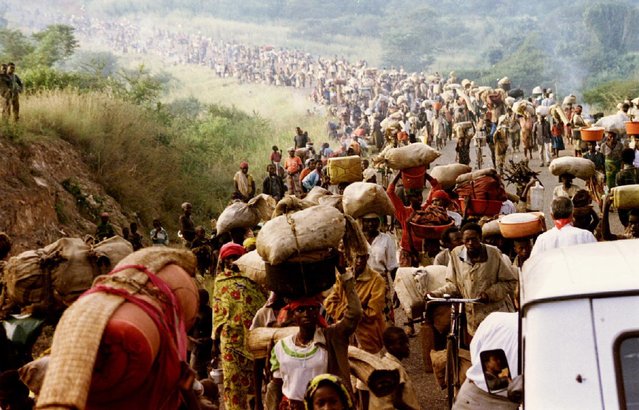
Rwandan refugees cross the Rusumo border to Tanzania from Rwanda carrying their belongings, goats, mattresses and cows, May 30, 1994. The bloodshed that claimed 800,000 Tutsi and moderate Hutu lives began 25 years ago on April 7, 1994, when a plane carrying Rwandan President Juvenal Habyarimana, Burundi President Cyprien Ntaryamira and a French air crew was shot down. (Photo by Jeremiah Kamau/Reuters)

A Rwandan Hutu refugee woman helps her daughter with an IV at the local hospital in the town of Goma in the former Zaire, now the Democratic Republic of the Congo, November 17, 1996. (Photo by John Parkin/Reuters)

Rwandan Hutu refugees rest on the side of the road next to the old Mugunga refugee camp near the border town of Goma in the former Zaire, now the Democratic Republic of the Congo, November 16, 1996. Hundreds of thousands of refugees fled the Mugunga and Sake refugee camps and were returning to Rwanda after being in the former Zaire for more than two years. (Photo by Reuters/Stringer)

Rwandan Red Cross workers help refugees as they crossed from the border into Gisenyi, Rwanda from the former Zaire, now the Democratic Republic of the Congo, November 17, 1996. (Photo by Reuters/Stringer)

An elderly Rwandan Hutu refugee woman begs for a ride to the Rwanda border in the former Zaire, now the Democratic Republic of the Congo, November 18, 1996. (Photo by Peter Andrews/Reuters)

A little Rwandan refugee, who traveled from Bukavu in the former Zaire, shivers in the early morning hours before getting back on the road to the border, November 30, 1996. He was part of a group of some 20,000 refugees, many suffering from disease and malnutrition, who made their way into Goma in what is now the Democratic Republic of the Congo, after being on the road for over one month. (Photo by Corinne Dufka/Reuters)

Belgian troops prepare to inspect the city of Kigali on the sixth day of violence, April 11, 1994. (Photo by Reuters/Stringer)

Dead Rwandans lie along the side of the road, some 70 kilometers north of the Rwanda-Tanzania border, May 8, 1994. (Photo by Corinne Dufka/Reuters)
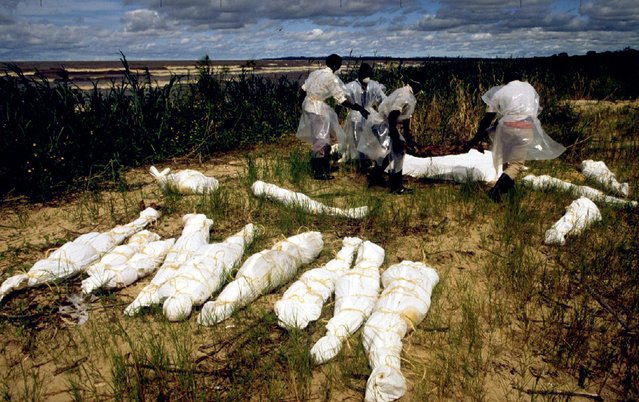
Ugandan fishermen pile up corpses for burial at Kasensero village 130 miles (208 kilometres) southwest of Kampala, Uganda May 20, 1994. The bodies were carried by Akagera river from Rwanda into Lake Victoria. (Photo by Reuters/Stringer)

Rwandan orphans hide in a nearby house after their orphanage was hit by shelling May 28, 1994. (Photo by Corinne Dufka/Reuters)
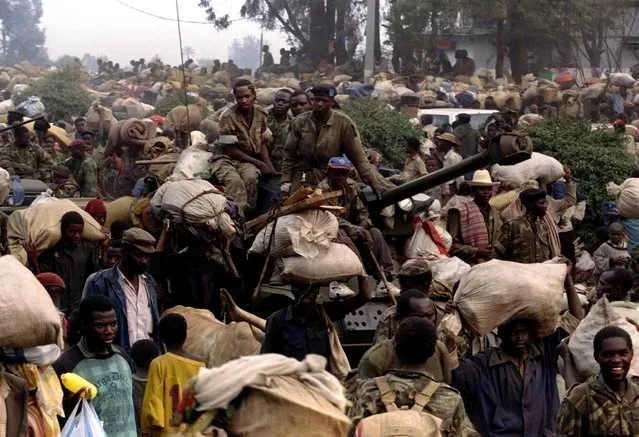
Rwandan government soldiers atop a tank equipped with a 90mm gun flee with civilians in front of advancing RPF forces, July 17, 1994. (Photo by Corinne Dufka/Reuters)

A Zairean soldier inspects piles of weapons confiscated from Rwandan government troops after they fled the border city of Gisenyi, Rwanda, July 18, 1994. (Photo by Corinne Dufka/Reuters)

A Rwandan refugee girl stares at a mass grave where dozens of bodies were laid to rest, July 20, 1994. (Photo by Corinne Dufka/Reuters)

A Rwandan woman collapses with her baby on her back alongside the road connecting Kibumba refugee camp and Goma, in the former Zaire, now the Democratic Republic of the Congo, July 28, 1994. (Photo by Ulli Michel/Reuters)

A Rwandan soldier suffering from cholera tries to sustain himself within a makeshift military hospital in Goma, in the former Zaire, now the Democratic Republic of the Congo, July 26, 1994. (Photo by Corinne Dufka/Reuters)
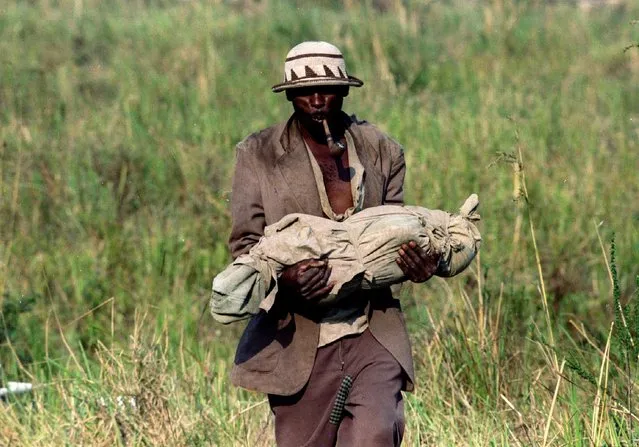
A Rwandan refugee walks through a field on his way to a mass grave carrying the body of his little baby who died of cholera, July 29, 1994. (Photo by Corinne Dufka/Reuters)

Friends and relatives lift a man wounded by a mortar fired by Rwanda Patriotic Front at a downtown government held area in Kigali July 1, 1994. The RPF seized control of Rwanda after driving the 40,000-strong Hutu army and more than 2 million civilian Hutus into exile in Burundi, Tanzania and the former Zaire, now Democratic Republic of Congo. (Photo by Corinne Dufka/Reuters)

A Rwandan Patriotic Front rebel observes a nail-spiked club found near a militia checkpoint which was abandoned after the rebel victory in Kigali, Rwanda July 7, 1994. The genocide lasted around 100 days and stopped after rebels fought their way to the capital, led by Paul Kagame, Rwanda's current president. (Photo by Corinne Dufka/Reuters)
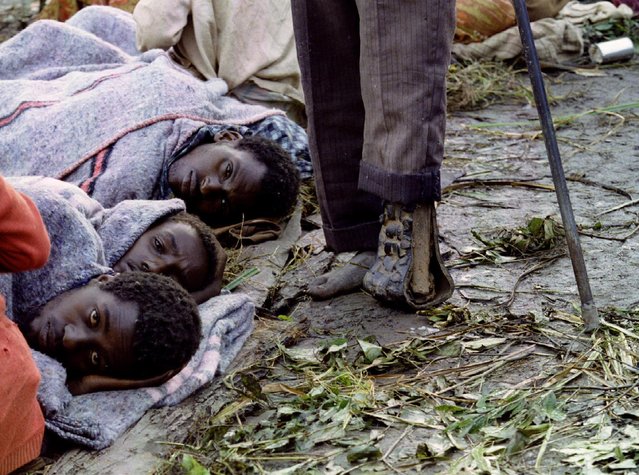
An amputee moves past three Tutsi refugees huddled together to protect themselves against the cold and damp in a camp in southern Rwanda, May 20, 1994. (Photo by Corinne Dufka/Reuters)

In this June 4, 1994, file photo, Nyabimana (first name unknown), 26, who was evacuated after being found by the Red Cross wandering in Kabgayi, about 15 miles southwest of the capital Kigali, shows machete wounds at an International Committee of the Red Cross hospital in Nyanza, about 35 miles southwest of Kigali, in Rwanda. The massacres, mostly by gangs wielding machetes, swept across Rwanda and groups of people were killed in their homes and farms and where they sought shelter in churches and schools. (Photo by Jean-Marc Bouju/AP Photo/File)

In this May 17, 1994, file photo, refugees who fled the ethnic bloodbath in neighboring Rwanda carry water containers back to their huts at the Benaco refugee camp in Tanzania, near the border with Rwanda. With a population surpassing 300,000, aid agencies are having difficulty feeding, treating and sheltering them. (Photo by Karsten Thielker/AP Photo/File)

In this December 19, 1996, file photo, tens of thousands of Rwandan refugees, who have been forced by the Tanzanian authorities to return to their country despite fears they will be killed upon their return, stream back towards the Rwandan border on a road in Tanzania. (Photo by Jean-Marc Bouju/AP Photo/File)
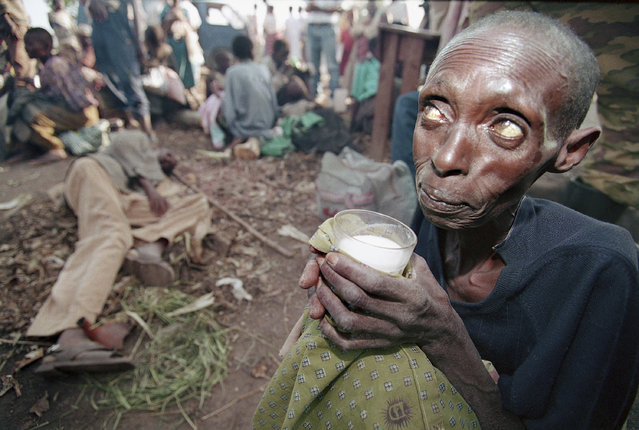
In this June 6, 1994, file photo, a starving woman, one of thousands of civilians caught in the fighting between government troops and the Rwandan Patriotic Front (RPF) rebels, sips milk at a makeshift health clinic in Ruhango, where doctors say 20 to 25 people die every day from disease and hunger, about 30 miles southwest of the capital Kigali, in Rwanda. (Photo by Jean-Marc Bouju/AP Photo/File)

In this June 9, 1994, file photo, a young orphan, his legs amputated below the knee, rests on a foam cushion near his artificial limbs at an orphanage in Nyanza, about 35 miles southwest of the capital Kigali, Rwanda. The scale of the killings in 1994 was unimaginable but the reporting and photographs taken at the time helped to inform the world of the horrors of the genocide. (Photo by Jean-Marc Bouju/AP Photo/File)

In this May 31, 1994, file photo, the bodies of a woman and her child lie by a church in Nyarubuye parish, which was the site of an April 14 massacre that survivors say was perpetrated by a militia assisted by government gendarmes, about 95 miles east of the capital Kigali, in Rwanda. The scale of the 1994 killings was massive and the reporting and photographs taken at the time helped inform the world of the horrors of the genocide. (Photo by Jean-Marc Bouju/AP Photo/File)

In this August 20, 1994, file photo, Rwandan refugee children plead with Zairean soldiers to allow them across a bridge separating Rwanda and Zaire where their mothers had crossed moments earlier before the soldiers closed the border, in Zaire, now known as Congo. Twenty-five years ago Rwanda descended into violence in which some 800,000 Tutsis and moderate Hutus were massacred by the majority Hutu population over a 100-day period in what was the worst genocide in recent history. (Photo by Jean-Marc Bouju/AP Photo/File)

In this May 31, 1994, file photo, the body of a man lies at the entrance to a church in Nyarubuye, Rwanda. The scale of the killings in 1994 was unimaginable but the reporting and photographs taken at the time helped to inform the world of the horrors of the genocide. (Photo by Jean-Marc Bouju/AP Photo/File)

In this July 27, 1994, file photo, a Rwandan Hutu refugee child desperately tries to waken his mother from a diseased sleep in the Munigi camp outside Goma, in Zaire, now known as Congo. The scale of the killings in 1994 was unimaginable but the reporting and photographs taken at the time helped to inform the world of the horrors of the genocide. (Photo by Javier Bauluz/AP Photo/File)

In this June 8, 1994, file photo, a little girl clutches the body of her mother, who died two days earlier of starvation, in the chapel of a seminary housing displaced Tutsis in Kabgayi. Rebels with the Rwandan Patriotic Front (RPF) found them six days after they took Kabgayi from government forces, who survivors said ran the compound as a concentration camp. (Photo by Jean-Marc Bouju/AP Photo/File)
08 Apr 2019 00:03:00,
post received
0 comments
